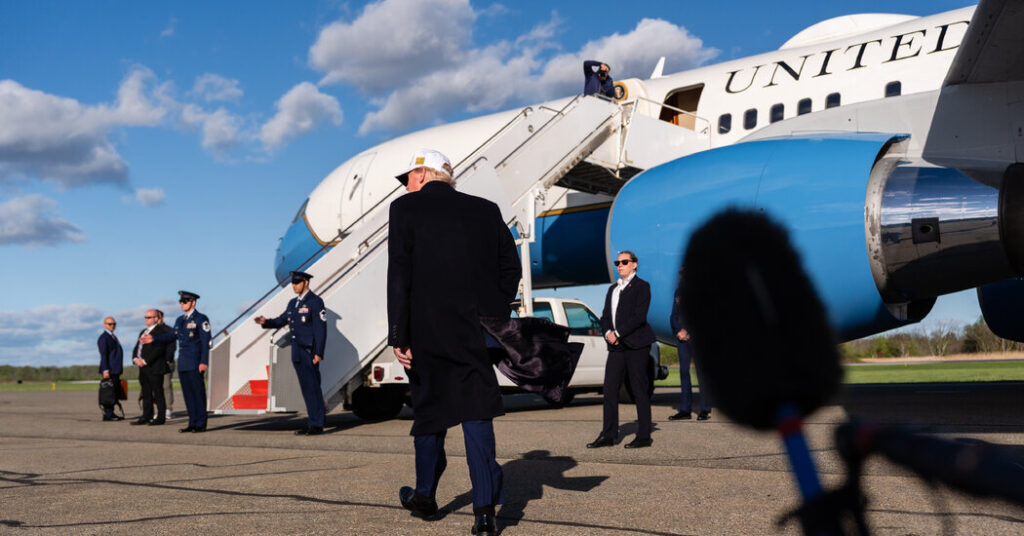President Trump has expressed the need for a more “impressive” Air Force One that rivals the sleek jets found in affluent Middle Eastern countries.
The current Air Force One aircraft, two 747-200s, are over 30 years old and were intended to be retired long ago.
Attempts to replace them over the past decade have faced numerous setbacks, with completion not expected before Mr. Trump’s departure from office—potentially as late as 2027.
As a result, he plans to accept a donation of a Boeing 747-8, dubbed a “palace in the sky,” from the Qatari royal family for the Pentagon, which would ultimately be transferred to his presidential library. This plan, currently under negotiation, has faced considerable backlash, including from within the Republican Party, but Mr. Trump staunchly defends it.
While the current Air Force One aircraft are safe, they are outdated, and airplanes have a limited lifespan before they must be retired.
“They are simply old planes — aircraft have finite lives,” stated Frank Kendall, the former Air Force secretary, who began efforts to replace the aircraft during the Obama administration. “There is no doubt these planes need to be replaced.”
Globally, there are fewer than two dozen 747-200s still operational, and sourcing spare parts for replacements often requires custom fabrication.
Presidential jets are typically in service for decades; the U.S. military first utilized the current 747 models in 1990, featuring three floors that include a conference room and specialized communication equipment.
The development of new jets intended for Air Force One—a designation for any plane carrying the president—has been a lengthy process.
This initiative began with President George W. Bush, who proposed the acquisition of two new presidential aircraft during his second term. He recognized the necessity of a dependable presidential jet during the eight hours following the Sept. 11, 2001, terrorist attacks when he and his advisers flew aboard Air Force One along the East Coast, the safest location available.
Under President Barack Obama, the plans for the new aircraft didn’t gain momentum until the final two years of his term. In 2015, the military selected Boeing to supply 747-8 frames for the upcoming jets.
These planes were meant to be retrofitted to endure potential radiation from a nuclear explosion, withstand specific missile threats, and possess aerial refueling capabilities.
The base cost for a 747 is around $250 million, but a final Air Force One aircraft could exceed $2 billion, according to Mr. Kendall, highlighting the extensive and time-consuming efforts required before the jet can serve the president.
The project encompasses constructing a flying version of the Situation Room, ensuring a communication system that allows the president to connect with any global military or political leader, establishing a mini medical clinic, and implementing defensive measures against enemy missiles.
“It’s not merely an airplane anymore,” Mr. Kendall emphasized. “It’s a flying White House.”
In 2018, facing slow progress on the aircraft, Mr. Trump’s administration renegotiated a contract with Boeing for two new 747-8 planes, using the frames from jets originally intended for a defunct Russian airline.
They were intended to include military enhancements and defensive technologies, with the hope that Mr. Trump could utilize them by the end of his first term.
However, the COVID-19 pandemic triggered further delays. The company responsible for creating the customized interior—beyond just seats and buckles—went out of business, and Boeing encountered supply chain shortages.
Additionally, Boeing dealt with various issues unrelated to the pandemic, such as the Federal Aviation Administration identifying significant cracks in the frames of other 747-8 models that necessitated extensive repairs.
Consequently, the delivery of the planes, originally expected by 2024, has been pushed back, and they might not arrive before Mr. Trump’s tenure concludes.
This delay has frustrated Mr. Trump, who has a background in aviation, having previously owned an airline shuttle service and multiple private planes, including a used 757, adorned with gold and mahogany furnishings.
The existing color scheme of his personal aircraft is blue, red, and white—similar to what he envisions for the new Air Force One, aiming to replace the current robins’ egg blue design. Since leaving office, Mr. Trump has frequently showcased a model of the proposed Air Force One at Mar-a-Lago, his private resort in Florida.
However, Mr. Trump appears to be more concerned with the aircraft’s aesthetics than their age. He feels they lack the symbolic grandeur that America should embody and believes that the leaders of oil-rich nations he visits often have more impressive jets than the one currently in use.
“The aircraft you are on right now is nearly 40 years old,” Mr. Trump remarked during an interview with Fox News host Sean Hannity aboard Air Force One while traveling to the Middle East.
“When you arrive and see Saudi Arabia, the U.A.E., and Qatar—all of which have brand-new Boeing 747s—it’s immediate that ours seems far less impressive. It appears much smaller and less striking,” he commented.
“As the United States of America, we deserve the most remarkable plane,” he asserted.
However, the acquisition of a Qatari jet is merely the beginning of a complex and prolonged process required to adapt it into a bona fide Air Force One, as noted by Mr. Kendall.
“What they will receive is a luxurious aircraft designed for an emir or royal family member, a lavish flying palace,” he stated. “But that does not equate to the capabilities and distinctive features of an Air Force One. The Air Force can apply the colors that President Trump desires, but it will not function as an Air Force One.”

